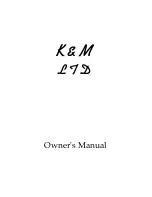
TECHNICAL SECTION
THE HAMMOND TONE GENERATOR
The A-100, A-101 and A-102 embodies the Hammond electro-mechanical tone generator
as its source of tone. A picture of this generator is shown below.
The generator assembly includes a shaded-pole induction motor for starting, a non-self-starting
synchronous motor for driving the unit after it is started, and a Vibrato Scanner mounted on the
synchronous motor. The entire assembly is mounted on two long steel angles which also provide
the means of mounting the tone generator in the console. The method of mounting is such as to
minimize the transmission of vibration from the tone generator to the console.
A drive shaft, resiliently coupled to the synchronous running motor, extends the entire length of the
generator. Twenty-four driving gears, two each of twelve sizes, are mounted on this shaft, and the
drive shaft itself is divided into several sections connected by flexible couplings. The starting motor
is mounted at the end of this drive shaft, opposite to the synchronous motor.
STARTING AND SYNCHRONOUS MOTORS
As mentioned above, a shaded-pole induction motor is used for starting the generator and is
located at the right end of the generator as viewed from the back. The rotor of this motor will slide
endwise when current is supplied and engage a pinion on its shaft with a gear on the generator
driving shaft.
When the organ is started, the starting switch is turned on and held for about 8 seconds while the
starting motor brings the system up to slightly greater than synchronous speed. The "run"switch is
then turned on. This switch simultaneously connects the synchronous motor and introduces a
resistor in series with the starting motor thus reducing its driving power. With a braking action of the
synchronous motor and a loss of power of the starting motor, the system slows to synchronous
speed and the synchronous motor begins to carry the load. A period of about 4 seconds should be
allowed for this to take place, after which the starting switch may be released. The starting switch
springs back to the "off" position, and turns off the starting motor, which is then disengaged from
the rotating shaft by a spring.
It should be noted that the synchronous motor can supply power only at synchronous speed.
Therefore, if for any reason the system fails to reach synchronous speed it will not continue to run
after the starting switch is released. Failure to start properly is usually due to increased oil viscosity
or low line voltage and may sometimes be overcome by a increase in starting time.
As the schematic diagram indicates, the "run" switch in its "off" position shorts out the wirewound
resistor attached to the line panel. If the "run" switch is defective in its "off" position, the generator
will not start because this resistor will be permanently in series with the starting motor. Before
assuming that there is anything amiss with the motors, short out this resistor and start the
generator in the normal manner. If the generator operates satisfactorily, replace the "run" switch.
7
tuttotastiere.com








































